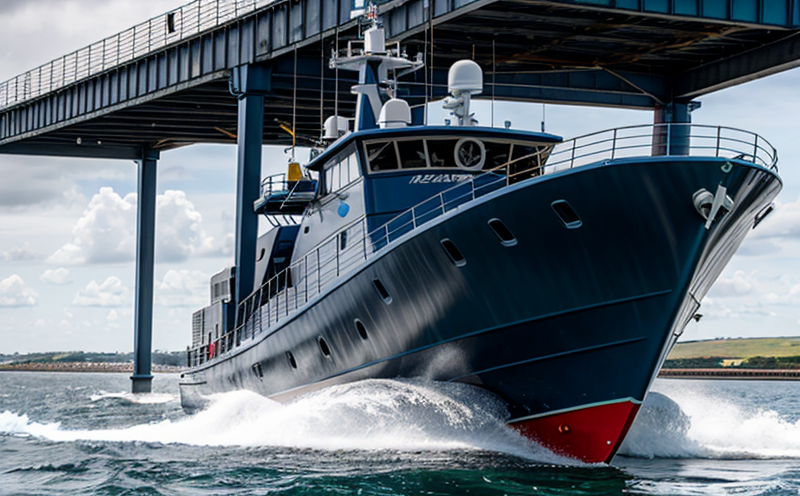DNVGL-CG-0338 Torsional Vibration Testing of Marine Shafts
The DNVGL-CG-0338 standard is a critical guideline for the torsional vibration testing of marine shafts. This service ensures that the mechanical integrity and performance of propeller shafts are validated, adhering to international safety standards.
Marine shafts play an essential role in the propulsion system of ships, transferring power from the engine to the propeller. The torsional vibrations generated during operation can lead to fatigue failure if not properly addressed. DNVGL-CG-0338 provides a robust framework for testing these shafts under simulated operating conditions.
The torsional vibration test is particularly important in ensuring compliance with the DNV GL Codes and international standards such as ISO 19402:2017. This service helps shipyards, engine manufacturers, and maritime operators to meet regulatory requirements and ensure the safety of their fleet.
The testing process involves subjecting the shaft to specific loads that mimic real-world conditions. The test setup includes a torsional rig capable of applying controlled torque pulses to the shaft. The instrumentation records critical parameters such as acceleration, displacement, and stress-strain behavior.
During the test, the shaft is rotated at various speeds, and the resulting vibrations are monitored using high-precision sensors. These sensors provide data that can be analyzed to determine the natural frequencies of the shaft system and identify any potential sources of torsional vibration issues.
The DNVGL-CG-0338 standard specifies acceptance criteria for both the structural integrity and dynamic behavior of the marine shaft. Compliance with these criteria ensures that the shaft is capable of withstanding operational stresses without excessive deformation or failure. The testing process also provides valuable insights into the design and manufacturing processes, allowing for continuous improvement.
By adhering to DNVGL-CG-0338, shipbuilders and engine manufacturers can ensure that their products meet the highest safety standards. This not only enhances operational reliability but also reduces the risk of costly repairs or replacements due to premature failure. The test results are typically documented in a detailed report that includes all relevant measurements, analysis, and recommendations for improvement.
Why It Matters
The DNVGL-CG-0338 torsional vibration testing of marine shafts is crucial for several reasons. Firstly, it ensures the mechanical integrity of the shaft system, which is vital for safe and efficient operation. Secondly, compliance with this standard helps shipyards and engine manufacturers meet regulatory requirements, enhancing their reputation in the maritime industry.
By identifying potential torsional vibration issues early on, DNVGL-CG-0338 testing prevents costly repairs or replacements. This not only reduces downtime but also minimizes maintenance costs. Additionally, the test results contribute to continuous improvement in design and manufacturing processes, leading to safer and more reliable ship systems.
The reliability of marine shafts directly impacts the overall performance of a vessel. A robust torsional vibration testing process ensures that the shaft can withstand the rigors of long-term operation without degradation. This is particularly important for vessels operating in challenging environments, such as harsh weather conditions or high-speed operations.
Scope and Methodology
| Test Parameters | Description |
|---|---|
| Torsional Rig Capabilities | Capable of applying controlled torque pulses to the shaft. |
| Sensor Types | Included: Accelerometers, Strain Gauges, and Displacement Meters. |
| Test Speeds | Varying from minimum to maximum operational speeds. |
| Data Collection | All measurements are recorded in real-time for detailed analysis. |
The DNVGL-CG-0338 torsional vibration testing process begins with the preparation of the marine shaft. This involves cleaning, inspecting, and ensuring that the shaft is free from any defects or contaminants. Once prepared, the shaft is mounted onto a torsional rig capable of applying controlled torque pulses.
The test setup includes various sensors such as accelerometers, strain gauges, and displacement meters. These sensors are strategically placed to capture critical data points during the testing process. The shaft is then rotated at varying speeds that simulate real-world operating conditions. The instrumentation records acceleration, displacement, and stress-strain behavior throughout each test cycle.
After completing multiple test cycles, the collected data is analyzed using advanced software tools. This analysis focuses on identifying any potential sources of torsional vibration issues. Key parameters such as natural frequencies, damping ratios, and mode shapes are calculated to assess the dynamic behavior of the shaft system.
Benefits
- Ensures compliance with DNV GL Codes and international standards.
- Identifies potential torsional vibration issues early on.
- Reduces the risk of costly repairs or replacements due to premature failure.
- Enhances operational reliability by ensuring mechanical integrity.
- Contributes to continuous improvement in design and manufacturing processes.
- Improves reputation within the maritime industry by meeting regulatory requirements.
The benefits extend beyond just compliance and safety. By conducting DNVGL-CG-0338 torsional vibration testing, shipbuilders and engine manufacturers can gain a competitive edge in the market. The test results provide valuable insights into the performance of marine shafts under simulated operating conditions, enabling informed decision-making throughout the design and manufacturing processes.





